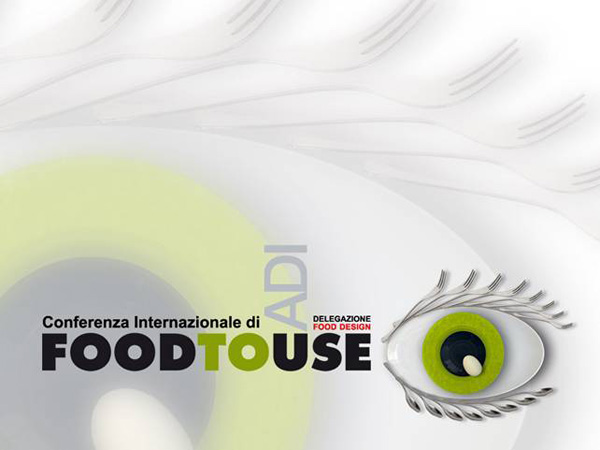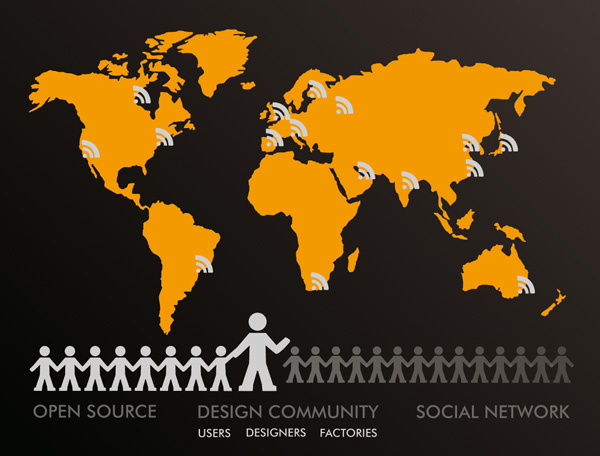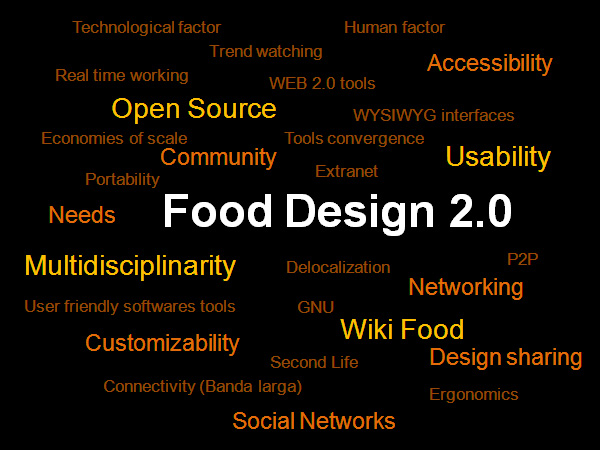Food Design 2.0 takes up web 2.0’s concepts, goals and contents. Web 2.0 is a new internet approach, a set of practices enabling users to actively take part in the network development. Differently from web 1.0, web 2.0 identifies an active approach; users directly participate in the network process of the content creation. Differently from the past, for example, when the editing process was just one nowadays everyone can work on it as it’s not necessary anymore to know the artificial programming languages. Web 2.0 has therefore enabled a real evolution for what concerns web principles and practices: web 2.0 has made it possibile to let everybody participate in the web process.
Food Design 2.0, as well as web 2.0, is an open source Design platform, where users create contents working on precise needs emerging in the Food & Beverage branch. Designers are supposed to design user friendly or capable interfaces, in order to satisfy the community need for a particular product.
Food Design 2.0, by Food Design Studio, is a working platform focused on design whose community keeps on exchanging data. Designers, companies and final users will therefore co-work from all over the world.WIKI FOOD DESIGN 2.0 is the possibility for a web 2.0 Design Community to co-work on the same project.
The open source model is focused on the industrial design and production fields, its working platform is about the nowadays well known Linux, Wikipedia, Knol, Forum, Blogs, Skype, Second Life and Augmented reality.
Linux and Wikipedia demonstrate both that the network offers an alternative knowledge sharing system.
Novell itself, a company offering enterprise infrastructure software and services, has changed the market rules buying a Suse Linux distribution, adapting it to its needs and redistributing it. Mandriva Linux as well is a an example of the same phenomenon. That’s why the design world has to deal with different business models, to think about the new knowledeg sharing systems the network enables.
In our Design 2.0 model communities are made up of consumers with particular needs, designers and companies able to satisfy the network requirements. Nobody has to pay anything, at least in the beginning; the pre-production process is open source. Once a company markets the final products, communities can buy them at easy terms or gain from royalties as part of the productive process.
WIKI FOOD DESIGN at Macef 2008. The web 2.0 platform of the present web site simulates such co-working laboratories by means of ftp sharing, p2p, blog, worldwide located laboratories as well as augmented reality and rapid prototyping. Politecnico di Milano, Facoltà di Ingegneria, and Marco Maggioni will give live design practical demonstrations at prearranged times; Augmented Reality enables you to see real time the final product.
Blackle, for instance, is the result of a 2.0 process (visit http://blackle.com or http://blackle.com/about/): think about the advantages such a project can bring if everybody adopted it or Google itself changed its Brand Identity.

Food Design 2.0 takes up web 2.0’s concepts, goals and contents; likewise Food Usability resumes the W3C web usability guidelines applied to real life Food Design and Food Design architecture.
ISO (International Standards Organization) provides the following definition for Usability: Usability is the “effectiveness, efficiency and satisfaction with which a specified set of users can achieve a specified set of tasks in a particular environment.” It evaluates the user-machine interaction, its efficiency and the user satisfaction.
There is a usability problem when the designer model (his idea of how the product should work, consequently the product design) and the final user one don’t match.
The higher or lower product usability depends on how close the two models are one to the other.
That’s why “Usable Food” design has to focus on functionality, ergonomics, accessibility, usability, anatomy, handiness and comfort.
Rationality, logic and savvy, as well as creativity, are the factors determining a product success; its friendly usability rewards all efforts.
To better design a product satisfying a particular need, the designer himself has to feel this need.
It will be possible to solve the difficulties a handicapped person has only by really knowing what these are.
Designers and final users need to interact and co-work, all this is made possible by the Food Design 2.0 platform.

It’s not that difficult as it appears to be, it’s about the application of car-, furniture- and home appliance design rules to the Food & Beverage branch.
Food Usability for Human needs. Food Design Studio first discovers and applies the Food Usability concepts to the Food & Beverage branch. Food to use and not to look at.
In Food Design ergonomics deals for the first time with parts of the human body interacting with the tools used to eat.
Particularly in the Food & Beverage branch it’s important to refer to the final consumer when designing a food interface.
It’s not Food Design what’s just decoration, Food Styling, Food Art, Food Show, media Food, as well as a simple form of food representation or communication.
“Food To Use”, when Design it’s not just about form.
Download the Power Point Food Design 2.0 presentation >>>
Keywords:
Food Designed around a human needs
Food created for human needs
Food made for a human needs
Food to Use
Food Usability
Open source wikifood
Utilism e supernormal by Jasper Morrison

